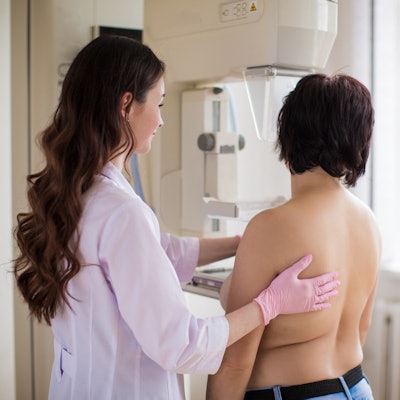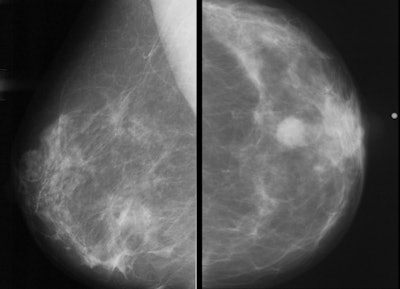
Women who are screened for breast cancer every two years have more advanced cancers -- as well as more cancers between screening rounds -- than those who are screened annually, according to a study to be presented next week at RSNA 2019 in Chicago. Those treated biennially also generally require more aggressive treatment.
Researchers scoured a breast imaging database at a U.S. National Cancer Institute designated cancer center and found breast cancer in more than 200 women. Most women underwent annual screening, while a smaller proportion screened biennially. The biennial group fared worse in terms of later-stage cancers, interval cancers, larger tumor sizes, and more aggressive treatment.
 Examples of normal (left) and abnormal (right) mammograms. All images courtesy of the RSNA.
Examples of normal (left) and abnormal (right) mammograms. All images courtesy of the RSNA."Screening mammography performed once a year resulted in less advanced-stage disease in patients diagnosed with breast cancer," said study co-author Dr. Sarah Moorman from the department of radiology at Michigan Medicine in Ann Arbor in a press release accompanying the study.
Annual vs. biennial
Among the issues in the debate surrounding screening mammography is its frequency: Which is better, annual or biennial? The National Comprehensive Cancer Network and American College of Radiology recommend annual screening beginning at age 40 for women at average risk for breast cancer, while the U.S. Preventive Services Task Force says screening every two years beginning at age 50 is sufficient for most women.
 Dr. Sarah Moorman.
Dr. Sarah Moorman."These differing recommendations lead to confusion for both referring physicians and patients," Moorman said.
She and her colleagues sought to weigh in by comparing breast cancer tumor characteristics and treatment regimens among women undergoing annual mammography versus those getting biennial screenings in the years 2016 and 2017 at the cancer institute. The study group included 232 women, ages 40 to 84, who were diagnosed with breast cancer. The two groups had no significant differences in baseline characteristics such as age, menopausal status, hormone replacement use, family history, and race.
The vast majority (86%) underwent annual screening, defined as once every nine to 15 months, while the remaining 32 had biennial screening, or once every 21 to 27 months. The mean age at cancer diagnosis among was 62. Almost three-quarters of the cancers were invasive. Other statistics are below.
| Clinical outcomes in annual vs. biennial screening | ||
| Biennial | Annual | |
| Late-stage cancers | 43.8% | 24% |
| Interval cancers | 38% | 10.5% |
| Median tumor size | 1.2 cm | 1.1 cm |
The study also found women who had biennial screening tended to have more aggressive treatment, such as chemotherapy and dissection of the axillary lymph nodes, where cancer from the breast often spreads.
"There were trends toward less frequent axillary lymph node dissection and less frequent use of chemotherapy with annual screening compared with biennial screening," Moorman said.
She hopes the findings of the study will help allow informed decision-making regarding screening frequency.



















